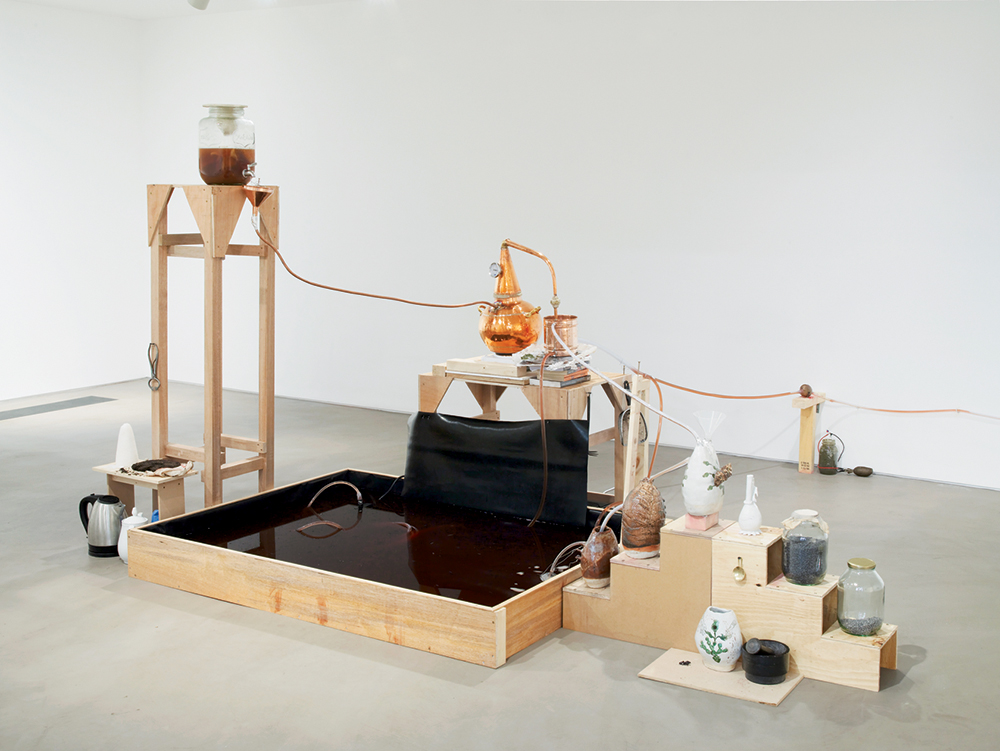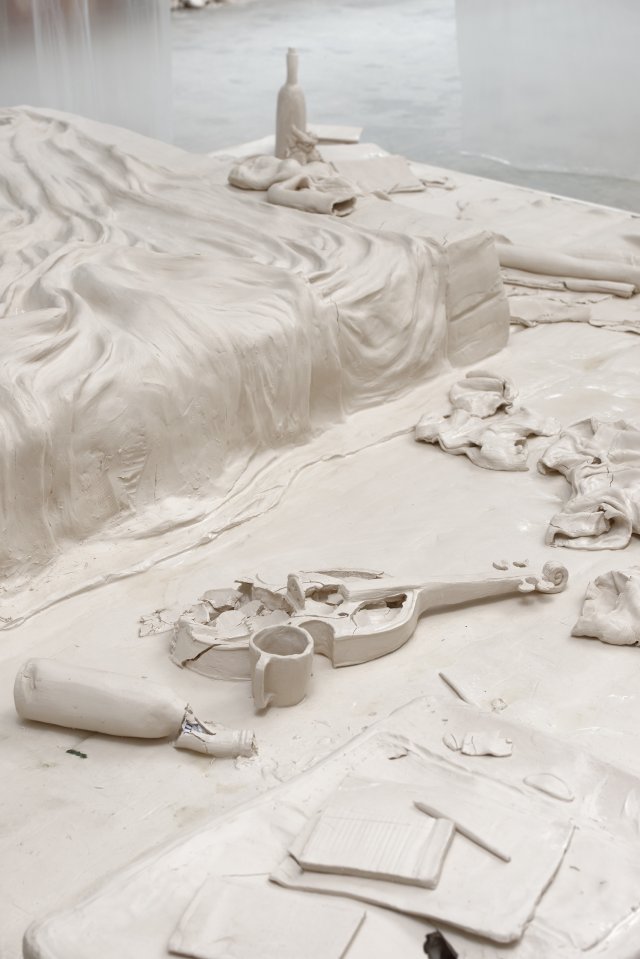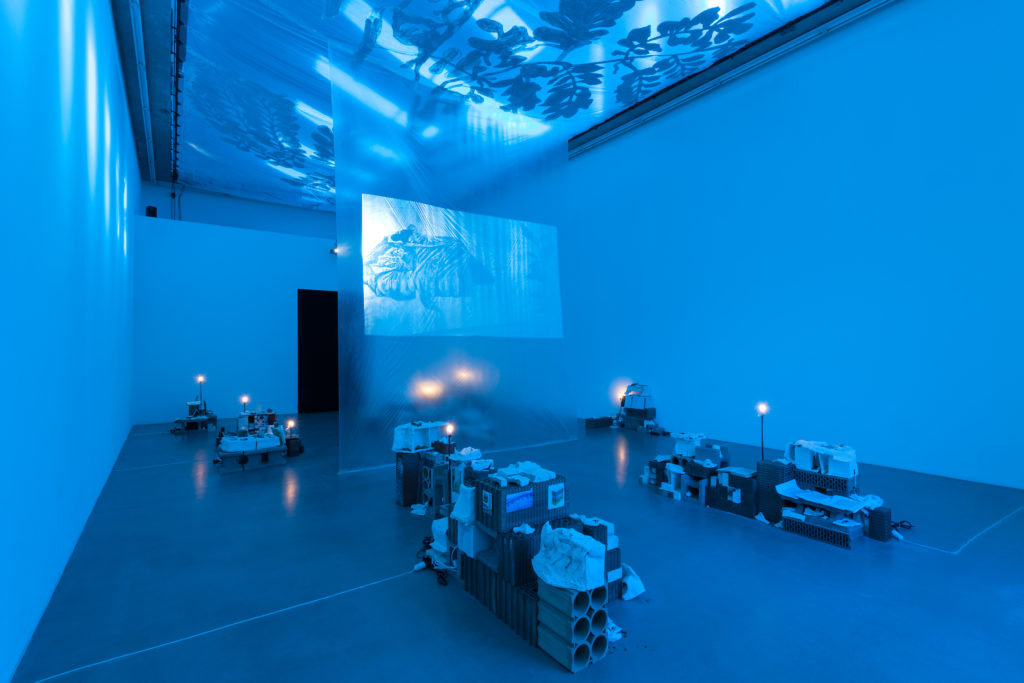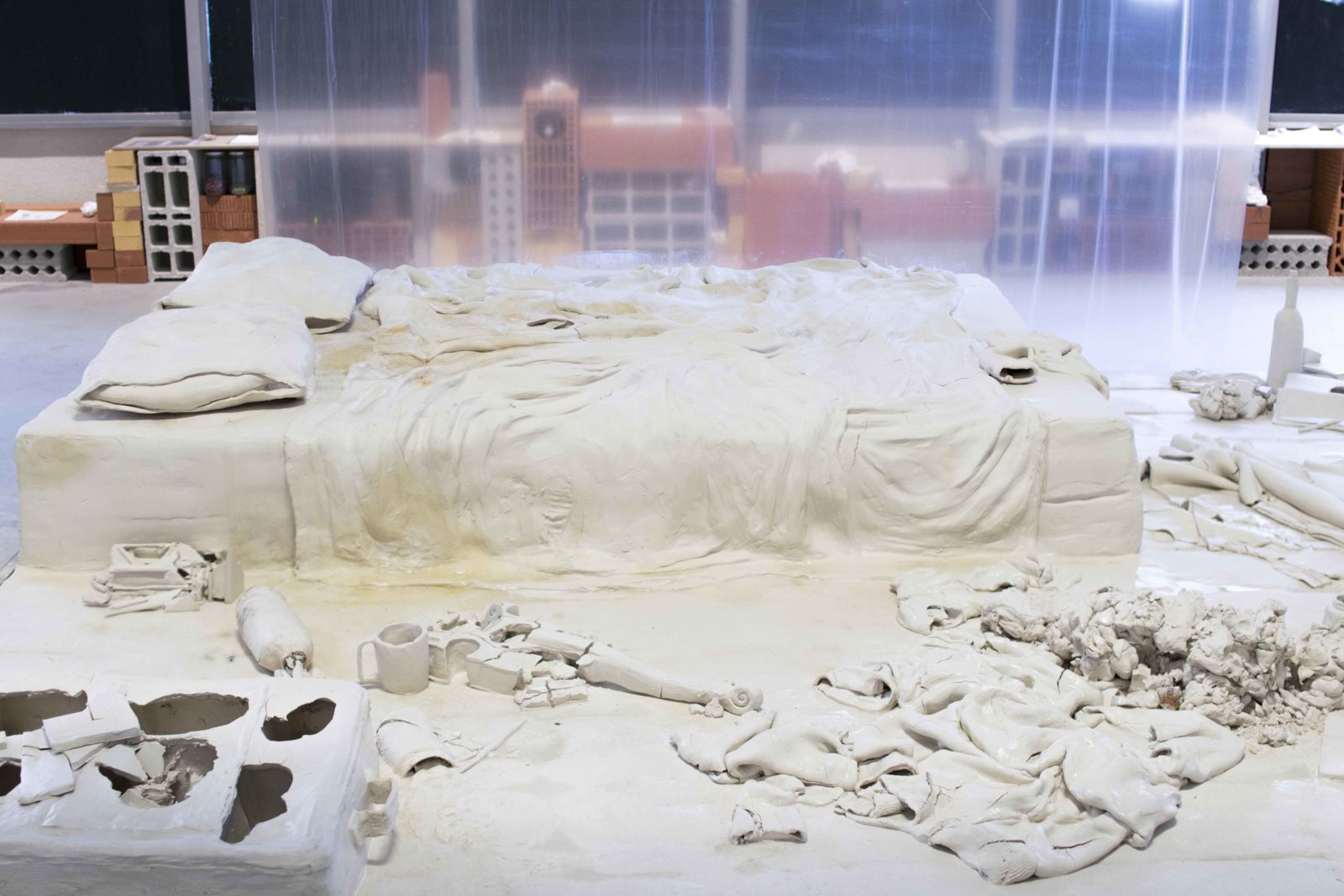Candice Lin: A Hard White Body, A Porous Slip // Logan Center for the Arts
by Jameson Paige

Candice Lin thinks through some of the most troubling scars of human history. Her work approaches the entrenched legacies of colonialism, racism, sexism, etc., with an intersectional attunement that provides relatable entryways into the magnitude of these oppressive structures. Transgressive historical figures who have been pushed aside for their non-normative identities invoke narrative lines for viewers to make sense of these complex, and often contradictory, pasts. Much of Lin’s practice, however, finds methods of unpacking these histories through dislocating human subjectivity altogether. In her exhibition A Hard White Body, a Porous Slip, currently on view at the Logan Center for the Arts at the University of Chicago, the artist continues her compelling research into how materials and non-sentient life carry similar baggage and trauma. In looking to the nonhuman, viewers of Lin’s work find that while the stakes of oppressive social systems have obviously fraught consequences for people, they also entangle and structure the rest of the world in a human drama—a maelstrom not easily escaped.
Jameson Paige: I think it would be useful to first discuss some of the conceptual and material interests that frame your exhibition, A Hard White Body, a Porous Slip, currently on view at the Logan Center for the Arts. In the brief curatorial statement, Yesomi Umolu outlines your tactical use of materials-in-process that ferment or decay, in order to imagine the historical legacy of colonial and imperial impulses. Can you speak a bit more on how these ideas first became of interest to you, and how they are animated within the exhibition?
Candice Lin: Yes—I had become interested in the material histories of cochineal and porcelain, which had in common the fact that they puzzled and seduced the Europeans who had come in contact with them. They could not figure out if cochineal—a dye derived from boiling the scales of female beetles yields an incredibly vibrant hue of crimson or scarlet—was an insect, a bezoar stone from an animal, a grain from a plant, or a mineral. And the recipe of porcelain could not be determined by Europeans for nearly two centuries, despite alchemical experiments and religious espionage. I wondered at how a seemingly insignificant thing—such as an insect or a lump of earth—could become an object of desire and luxury. The more I read about these two materials, the more I was brought into a web of other colonial goods—sugar, tea, opium, potatoes, and silver. My exhibition at Gasworks in 2016, entitled A Body Reduced to Color, sought to create a system that recirculated these colonial goods into new relations through processes that mimicked those that have made such goods precious: the refining of sugar, the fermentation of tea, the distillation of molasses into rum. Instead of creating a singular alluring product, my installation produced a foulsmelling amalgamation, a stain. I continued this method of inquiry in the first iteration of A Hard White Body, which took place in Paris at Bétonsalon in the fall of 2017, where I used the distillation of urine—steeped in a decoction of plants—to play with ideas of contagion, toxicity, caretaking labor, and the impossibility of purity. In this prior version of the exhibition, the porcelain, that you see reappear as fragments in the Logan Center at the University of Chicago, was the scene of an unkempt domestic bedroom made of 1000 kilograms of unfired porcelain. This bedroom was cared for by the people who worked at Bétonsalon, who provided the urine along with visitors, which was distilled and pumped up through a misting system to keep the fragile sculpture from cracking and falling apart. It was a way to materially embody the instability of the histories I was working with, and to make visible the bodily porosity, fragile ecosystems, and ongoing labor present in those histories.
JP: I think the historical nodes you point to also fall into larger efforts being made in historic and cultural studies to lift up the marginal, overlooked, or suppressed figures in these complex histories. Though your linkage of three figures—James Baldwin, Jeane Baret, and Maria Sibylla Merian—is perhaps what is most unique. Why these three rather than others, and to what ends? How do these three emerge in the exhibition?
CL: The room I just described, which was the central installation of A Hard White Body / un corps blanc exquis, was modeled upon how I imagined the apartment described in James Baldwin’s novel, Giovanni’s Room, which was situated in a neighborhood of Paris and drew from the time he spent there. It also incorporated elements of the cramped ship cabin that Jeanne Baret traveled around the globe in, cross-dressing as the male valet to her lover and employer, Philibert Commerson. I was interested in the way that both James Baldwin and Jeanne Baret—though separated by geographies, and existing within different centuries of time—lived out identities, in a way that so confused their contemporaries that they were described in terms that conflated and confused their sexuality with their race or gender; or their gender with class and race. Baldwin was described by Eldridge Cleaver as “a white man in a black body,” through feminizing ‘womb’ rhetoric. Baret was described by the ship’s doctor as being able to pass as a man because of her sun-browned roughened skin and strong physical strength. This seemed related to my interest in the racialized language attributed to porcelain, which was lauded for being “pure white,” “superior,” and “impervious to staining by foreign products such as coffee or tea.”
This descriptive quality is similar to what I mentioned before about how cochineal was unclassifiable and confounding, pointing to both the limits of the scientific technology and the current taxonomy of its time. Both Baldwin and Baret lived out different kinds of lives through their displacement from their homeland, as did Maria Sibylla Merian—who was part of the Frankfurt leg of the show at Portikus, A Hard White Body, a Soft White Worm. Merian was a Frankfurt-born woman who moved to the Netherlands, where she lived in a religious cult, and traveled in her 50s to Dutch Suriname to study caterpillars and plants, as well as to ostensibly look for a lucrative replacement to the silkworm or any other insects that could become profitable colonial products. In this context, Merian was better known and was brought in as a site- specific connection to Jeanne Baret. But both Baret and Baldwin had things missing from the archives. In the case of Baret, she has no archive; there is a notebook in Commerson’s archives at the Museum of Natural History in Paris that is perhaps written by Baret but there is no way to confirm this. In Baldwin’s archive, which just became partially accessible to the public in April 2017, there continue to be restrictions upon what can be seen or reproduced.

JP: Your practice is extremely research-heavy. Has research always been a driving element of your work? How do decisions about content drive your material inquiries, and vice versa?
CL: I think about my material experiments in the studio as part of my research— sometimes an obsession with clay will drive a curiosity to have me read more about its history, or sometimes an account of a text I am reading will fuel my interest in a topic or several topics. In the case of the Gasworks exhibition, Lisa Lowe’s 2015 book, The Intimacies of Four Continents got me interested in the history of dye, and her account of 19th century Chinese coolie labor helped to form my recent exhibition La Charada China at the Hammer Museum in Los Angeles. Anna Tsing’s book The Mushroom at the End of the World got me interested in mushrooms, which I then cultivated and grew using distilled piss in my studio. It goes both ways.
JP: Chicago’s notoriously problematic 1893 Columbian Exposition plays a role in this current installation. Having the work at the Logan Center means you are not far from where the Exposition occurred—has this proximity brought up notions of site-specificity? Are there components pulled from the present-day site of the world’s fair? What drew you to that event, or was it simply too much of a behemoth to not address?
CL: I generally try to find a site-specific connection within my exhibitions to ground the work in the location it is displayed, even if it is only one node of several being woven together by the work. In the case of the Chicago Columbian World Fair, there was a strange coincidence. I had been learning about porcelain’s use as a scientific filter in the nineteenth century. It was one of the only materials that was dense enough to separate bacteria in order to be studied. Charles Chamberland, one of Louis Pasteur’s assistants during these scientific trials using porcelain as a filter, developed a porcelain filter for domestic use to get rid of waterborne illnesses. These filters were first introduced to an American public at the Chicago World Fair. The organizers paid $10,000 to have large porcelain tanks brought in and connected to piping and spigots. These were located at different points in the fair—probably in the White City not the Midway—for fairgoers to have clean water to drink. I am continuing to think about the racialized aspect of porcelain’s history and the way its whitened ‘purity’ and ‘superiority’ was echoed in the Fair’s layout and language, as well as a continued preoccupation with cleanliness and contamination.
JP: I want to return to the exhibition’s framing, because I find the title fascinating both for its iterative quality and variable depth of meaning. A Porous Slip initially made me think of ceramic slip casts. Yet, I quickly became interested in all the other potential meanings provided by “slip.” A slip can be a minor or careless mistake; the fall to a lower or lesser standard; or a loosefitting undergarment typically worn by a female-bodied person. For such a simple four-letter word, it really packs some heat! What were your reasons behind titling this show, and were these ambiguities intentional?
CL: The “porous slip” in the title does refer to the process of ceramic slip casting, which was how the domestic porcelain filters were made by Chamberland and Pasteur. The idea of their filters was to create an unglazed slip-cast filter that remained porous enough to allow water to pass through, but dense enough to keep the bacteria on the other side. But yes—I was also interested in the other meanings of the term, and the way it indicates an accidental crossing of boundaries, for example —a slip of the tongue, something that is not intended or wanted but “slips through”—again relating to unconscious desires, beliefs, or fears of contamination.

Gallery, Los Angeles. Photo Credit: Brian Forrest.
JP: Thinking through language again, the operative words that have been used to describe your work—such as decaying, fermenting, breathing, seeping, staining, etc.—entail a type of slowness. They are processes that often cannot be seen by the naked eye. Rather, they require multiple visits or observations over time. Can you trace how, for example, stain-resistant porcelain sculptures will become marked, and what this gesture might illuminate? Why do you purposefully employ processes that resist instant gratification?
CL: It is interesting that you point out the slowness of these processes, which I had not thought of before—I am actually a very impatient person. I often say that impatience is my tragic flaw. I see these exhibitions as opportunities to set up scenarios that are beyond my mastery or control in terms of outcome, in order to see what gets made when materials are put in new relations to each other. They are also situations that are too large in scale for my small studio, or require a length of time to congeal into something else that I do not have patience to attend to alone. By enlisting the institutional labor into the caring for the live materials and unstable processes, I instigate a collaborative, implicated process that relies on (and is indebted to) the intimate investment of other people’s care. It is also open to outside forces that shape its outcome—meaning, I have an idea of what will happen, but it is often different or has unexpected “problems” that create different outcomes (mushrooms and mold growing out of the porcelain room for instance). I think it is important to move away from the idea of the artist as an individual performing a kind of virtuoso or mastery, and my use of materials attempts to embody that belief.
JP: Can you speak about the work you have included in the exhibition recently on view at Ghebaly Gallery in Los Angeles? What comes next after this iterative series of exhibitions—have any new questions excited your attention?
CL: Yes—my new research and body of work is focused on the history of nineteenth century Chinese coolie labor in the Caribbean, Louisiana, and California. In these works, I am thinking about the role of plants in this somewhat forced migration of labor, and how it might relate to other entanglements with plants—such as the role of poison in the Haitian revolution—that occurred in overlapping geographies.

Courtesy the artist, Bétonsalon, Paris, and Ghebaly Gallery, Los Angeles. Photo Credit: Aurélien Mole.
JP: One of the elements I have found particularly compelling about your work are how questions of embodiment arise. I have found that the effects of colonial or imperialist projects are often mapped by looking to the human body, either in epidermal, corporeal, or affective terms. Your work also does this through, for example, the triangulation of Baldwin, Baret, and Merian. However, I am particularly struck by your inclusion of non-human and even non-sentient life into the installations. Why locate embodiment, or one could even say a performativity, at these multiple levels?
CL: I am interested in decentering the human from how we think of history in order to think about the huge effects of seemingly small, dismissed, or invisible beings—viruses, bacteria, insects. I am also interested in how humans enlist the natural world, particularly plants, in order to experience it differently, or to mediate their relations to one another. Merian recorded in her book, the Metamorphosis of the Insects of Surinam, that there was a particular plant, the peacock flower, that was used by enslaved Indigenous and African women to bargain for power by using or threatening to use this plant to abort their future children. I think that when we think about the world from a decentered perspective of entanglement rather than dominion—or when we think of ourselves as conglomerates (biologically, socially, globally)—we gain an understanding of how our actions do not take place in a vacuum, but are instead tied to an intricate web of other effects that ripple outward through time.
Candice Lin is an interdisciplinary artist who works with installation, drawing, video, and living materials and processes, such as mold, mushrooms, bacteria, fermentation, and stains. Lin has had recent solo exhibitions at Portikus, Frankfurt; Bétonsalon, Paris; and Gasworks, London, as well as group exhibitions at the Hammer Museum (2018), LA; Moderna Museet, Stockholm (2017); New Museum, New York (2017); SculptureCenter, Long Island City, New York (2017), among others. She is the recipient of several residencies, grants, and fellowships, including the Louis Comfort Tiffany Award (2017), California Community Foundation Award (2014), Fine Arts Work Center Residency (2012) and Smithsonian Artist Research Fellowship (2009).